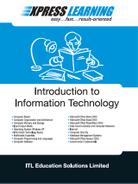13
Data Communication and Computer Networks
1. What is meant by the term ‘data communication’? What are its components?
Ans.: Data communication is the exchange of data between two devices using some form of wired or wireless transmission medium. It includes the transfer of data, the method of transfer, and the preservation of the data during the transfer process. To initiate data communication, the communicating devices should be a part of an existing communication system. For data communication to be effective, the following three fundamental characteristics should be considered:
- Delivery: The system must deliver data to the correct or the intended destination.
- Accuracy: The system must deliver data accurately (error free).
- Timeliness: The system must deliver data in a timely manner without enough time lags.
There are five basic components in data communication system:
- Message: It is the information that is to be communicated.
- Sender: It is the device that sends the message.
- Receiver: It is the device that receives the message.
- Medium: It is the physical path that communicates the message from sender to receiver.
- Protocol: It refers to a set of rules that coordinates the exchange of information. Both sender and receiver should follow the same protocol to communicate data. Without the protocol, the sender and receiver cannot communicate with each other; just as a person speaking English cannot be understood by a person who knows only Hindi.
2. Explain different data transmission modes.
Ans.: Data transmission mode refers to the direction of signal flow between two linked devices. There are three types of transmission modes:
- Simplex: This transmission mode is unidirectional. The information flows in one direction across the circuit, with no capability to support response in the other direction. Only one of the communicating devices transmits information, the other can only receive it. Television transmission can be considered as an example of simplex mode of transmission where the satellite only transmits the data to the television, vice versa is not possible.
- Half-duplex: In this transmission mode, each communicating device can receive and transmit information, but not at the same time. When one device is sending, the other can only receive at that point of time. In this mode, the entire capacity of the transmission medium is taken over by the device, which is transmitting at that moment. Radio wireless set is an example of half-duplex transmission mode where one party speaks and the other party listens.
- Full-duplex: This transmission mode (also known as the duplex mode) allows both communicating devices to transmit and receive data simultaneously. It can be compared to a two-way road with traffic flowing in both directions. A standard voice telephone call is a full-duplex call because both parties can talk at the same time and be heard.
3. Write in brief on analog and digital signals.
Ans.: The major role of the physical medium is to move the data from one communicating device to another. The data can be transmitted by means of electromagnetic signals. These signals may be in one of the two forms: analog or digital. Depending on the form of signal used, data transmission can be analog or digital data transmission.
Analog Signal
It is a continuous waveform that changes smoothly over time. The sine wave is the most fundamental form of an analog signal. Sine waves can be described by three characteristics (Figure 13.1):
- Amplitude: It is the value of the signal at any point on the wave. The maximum amplitude of a sine wave is the highest value it reaches on the vertical axis. The unit for amplitude depends on the type of the signal. For electrical signals, the unit is normally volts and amperes.
- Frequency: It refers to the number of cycles a signal completes in one second. In other words, frequency means the number of times a signal wave goes up and down in a second and it is measured in hertz (Hz). For example, if a signal wave completes one cycle in one second then its frequency is 1 Hz.
- Wavelength: It refers to the distance between successive similar points of a given wave, that is, one cycle of the waveform.
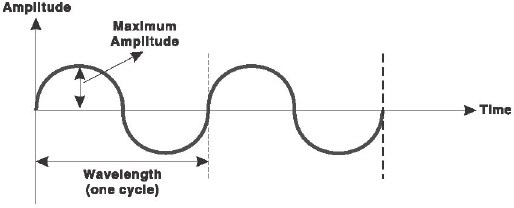
Figure 13.1 Analog Signal
Analog signal is perfect for carrying data such as voice or sound. However, it is prone to errors or noise that can be caused by the outside sources. Attenuation is another problem with analog signals because the amplitude of the wave naturally changes over distance.
Digital Signals
It is the data stored in the form of 0’s and 1’s. When the signal is at a high point, its value is 1 and when it is low, its value is 0. A signal in digital format has precise voltages that are not affected by noise or attenuation as compared to analog signals, which are very prone to noise. It can be represented by a graph similar to a bar graph. Figure 13.2 illustrates the digital signal in which ‘1’ can be encoded as a positive voltage and ‘0’ as zero voltage.

Figure 13.2 Digital Signal
To transmit data over analog phone lines, a modem is required to convert the digital data signals to analog signals. When transmitted over long distances, analog signals require to be amplified, which can possibly distort the value of the data transmitted. When analog data are converted to digital data, they can be transmitted over digital signals faster and without distortion.
4. Define the term ‘transmission media’. Explain the different types of transmission media.
Ans.: Transmission media refers to the physical media through which data can be transmitted from one point to another. It can be divided into two broad categories: guided or wired media and unguided or wireless media.
Guided or Wired Media
This media uses a cabling system that guide the data signals along a specific path. Cable is the medium through which information usually moves from one network device to another. It consists of a cable composed of metals like copper, tin, or silver. The data signal in guided medium is bound by the cabling system; hence, guided medium is also known as bound medium. There are three basic types of guided media:
| Twisted pair: The name of this guided media comes from the fact that each individually insulated conductor is part of a pair, making this a balanced medium, and that each pair is twisted together along its length, which helps to further protect it from interference from external sources. Each pair consists of a wire used for receiving data signal and a wire used for transmitting data signal. Twisted pairs are used in short distance communication (less than 100 m) and it comes in two forms: unshielded and shielded with a metal sheath or braid around it. The two are commonly known as unshielded twisted pair (UTP) and shielded twisted pair (STP). | |
| Coaxial cable: It has a single central conductor, which is made up of solid wire (usually copper). This conductor is surrounded by an insulator over which a sleeve of metal mesh is woven to block any outside interference. This metal mesh is again shielded by an outer covering of a thick material (usually PVC) known as jacket (Figure 13.3).
Figure 13.3 Coaxial Cable Although coaxial cabling is difficult to install, it is highly resistant to signal interference. It can support greater cable lengths between network devices than twisted pair cable. In addition, as compared to twisted pairs, it also offers higher bandwidth. It is capable of transmitting data at a rate of 10 Mbps. It is more expensive per foot, but cheaper per bytes of data transferred in a second. It is very robust and is commonly used in cable TV network. |
|
| Optical fibre: It consists of thin glass fibres that can carry information in the form of visible light. The typical optical fibre consists of a very narrow strand of glass called the core. Around the core is a concentric layer of glass called the cladding. A typical core diameter is 62.5 microns (1 micron = 10-6 m). Cladding generally has a diameter of 125 microns and is covered by a protective coating of plastic, known as jacket (Figure 13.4). |
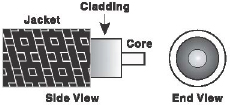
Figure 13.4 Optical Fibre
Unguided or Wireless Media
It facilitates data transmission through earth's atmosphere (air, water, or vacuum) at a much faster rate and provides wide area coverage. The data signals are not guided or bound to a fixed channel to follow. Some commonly used unguided media of transmission are discussed as follows:
| Microwave transmission: It uses microwave signals that travel at a higher frequency and are popularly used for transmitting data over long distances. Microwave communication uses parabolic antennas (satellite TV dish antennas) that are mounted on the tower, which could be tens of kilometres away, but in line of sight. Due to long distances, repeaters are used at regular intervals in between the transmitter and the receiver to boost the signals. Normally, the distance between the repeaters goes up roughly with the square root of the tower height. For example, for a 100 m high tower, repeaters can be spaced at 80 km apart. | |
| Satellite transmission: It is also a kind of line of sight transmission. Satellites are set in geostationary orbits directly over the equator, which rotates in synchronization to earth, hence look stationary from any point on earth. These geostationary orbits are placed 36,000 km above the earth's surface. The communication is carried through uplinks and downlinks. The uplink transmits the data to the satellite and downlink receives the data from the satellite. Uplinks and downlinks are also called earth stations because they are located on the earth. The area shadowed by the satellite in which the information or data can be transmitted and received is called the footprint. | |
| Infrared wave transmission: Infrared frequencies are just below the visible light spectrum. These are the high frequency waves used for short-range communication. The waves are cheap, directional, and can be easily built; however, the waves do not pass through solid objects. Infrared waves are used in TV remotes, garage doors, and wireless speakers. Computer machines in an office can easily be connected in wireless LAN using infrared waves. |
5. Differentiate between guided and unguided transmission media.
Ans.: In order to transmit a message or data from a source to a destination, one needs a transmission medium. Transmission media can be broadly classified into two categories: guided and unguided media. The differences between these two transmission media are listed in Table 13.1.
Table 13.1 Differences Between Guided and Unguided Media
S. No. |
Guided Media | Unguided Media |
1. |
Signal is transmitted by establishing a physical path between the source and destination. | No physical path is established between the source and destination and signals are propagated through air. |
2. |
Signals propagate in the form of current or voltage. | Signals propagate in the form of electromagnetic waves. |
3. |
Guided media are well suited for point to point communication. | Unguided media are well suited for broadcast communication. |
4. |
Examples of guided media are twisted pair cables, coaxial cables, and fibre-optic cables. | Examples of unguided media are microwave satellites, infrared waves, and radio waves. |
6. Write a short note on UTP and STP cables.
Ans.: UTP (unshielded twisted pair) cable is the most common type of telecommunication medium in use today. It is most suited for both data and voice transmission, hence is commonly used in telephone systems. The cable has four pairs of wires inside the jacket. Each pair is twisted with a different number of twists per inch to help eliminate interference from adjacent pairs and other electrical devices: the tighter the twisting, the higher the supported transmission rate and the greater the cost per foot. Each twisted pair consists of two metal conductors (usually copper) that are insulated separately with their own coloured plastic insulation (Figure 13.5).
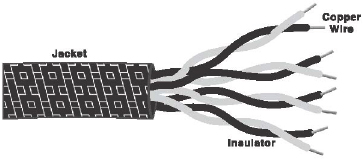
Figure 13.5 Unshielded Twisted Pair Cable
STP (shielded twisted pair) cable has a metal foil or braided-mesh covering that covers each pair of insulated conductors. The metal foil is used to prevent the infiltration of electromagnetic noise. This shield also helps to eliminate crosstalk, a phenomenon that can be experienced during telephone conversation when one can hear another conversation in the background. A disadvantage of UTP is that it may be susceptible to radio and electrical frequency interference. STP is suitable for environments with electrical interference; however, the extra shielding can make the cables quite bulky (Figure 13.6).
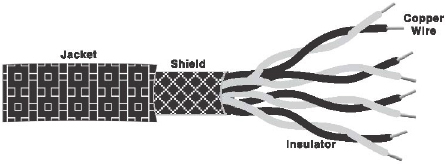
Figure 13.6 Shielded Twisted Pair Cable
7. Discuss some advantages and disadvantages of optical fibre.
Ans.: Fibre-optic cable is widely used in many domains such as telephone network and cable television network. Some of the advantages of optical fibre are as follows:
| Since transmission is light-based rather than electricity, it is immune to noise interference. | |
| Transmission distance is greater than other guided media because of less signal attenuation (degradation in quality over distance). | |
| It is extremely hard to tap into, making it desirable from the security point of view. | |
| It is smaller and lighter than copper wire and is free from corrosion as well. | |
| It offers, by far, the greatest bandwidth of any transmission system. | |
| Transmission through fibre-optic cable requires lesser number of repeaters for covering larger transmission distances. |
Some of the disadvantages of optical fibre are as follows:
| It is expensive as it is costly to produce, maintain, and install. | |
| The propagation of light is unidirectional and often requires precise alignment. | |
| Extending the fibre-optic cables by joining them together is a tough task. | |
| It is more fragile as fibre optic tends to break easily as compared to copper wires. |
8. Write short notes on the following:
(a) Bluetooth
(b) Wi-Fi
Ans.: (a) Bluetooth: This system is named after a Danish king Harold Blatand (Bluetooth in English). The Bluetooth technology is used to create a personal area network (PAN) or piconet that lets electronic devices such as computers, cell phones, PDAs (personal digital assistants), wireless keyboards, etc. to communicate with each other within the range of 10 m. It uses radio signals that are omni-directional, signals that travel in all directions from the source. Hence, the communicating devices need not be aligned with each other. When Bluetooth-capable devices come within range of one another, an electronic conversation takes place to determine whether they have data to share or whether one needs to control the other. The user does not have to manually operate on the devices, as connections are set automatically. Once the conversation has occurred, devices form a piconet. Once the piconet is established, the member devices randomly hop frequencies in unison so they stay in touch with one another and avoid other piconets that may be operating in the same room.
The key features of Bluetooth are its robustness, low complexity, and low power requirements that make it suitable for handheld devices like cell phones, PDAs, etc. Today, almost all the small handheld devices are Bluetooth-enabled. The Bluetooth radio-link uses a fast acknowledgement and frequency-hopping scheme to make the link robust. However, the maximum data transmission rate that it supports is only one mega bit per second, which makes it unsuitable for exchanging large files or folders. Moreover, the maximum range for this technology is 30 ft, which limits the space of personal area network (PAN) and the connection accessibility for electronic devices to perform an action.
(b) Wi-Fi: It stands for wireless fidelity. It is widely used for creating wireless LANs and also for providing wireless Internet access. To create wireless LAN, the devices in the network such as computer, laptop, PDA, etc., should be equipped with wireless network interface card to send and receive Wi-Fi signals. A Wi-Fi enabled device should be within a specific range (i.e., up to 50 m) from the network to connect to it.
The major benefit of Wi-Fi is that it allows developing low-cost wireless networks by reducing the cost of wires for connecting devices. Elimination of wires enables the wireless devices to move from one location to another (within the range) without losing the connectivity. However, the weak security is one of the disadvantages of Wi-Fi that makes the wireless network vulnerable to attack from the intruders. Wi-Fi signals are not confined to the boundaries of building (in which the wireless LAN is operating), thus any intruder can easily gain access to the network by standing outside the building. Another disadvantage of Wi-Fi network is its susceptibility to interference from other devices operating in the same area such as wireless phones, other wireless networks, etc.
9. What are the disadvantages of wireless links?
Ans.: Although wireless links have eased the lifestyle a lot, they have still got many disadvantages:
| They suffer from lower bandwidths. This means that the channel capacity available in these links is lower because of the limited availability of spectrum. | |
| There is higher error rate in wireless links due to noise and interference. | |
| The security is a greater issue in wireless links as the information is travelling in free space (air) in the form of signals and it is convenient for the hackers to catch wireless signals. They require very tight security so that the unauthorized users cannot exploit the information. Therefore, a much stronger level of authentication and strong security protocols are required to secure the wireless signals. | |
| The extensive use of wireless signals over the mobile phones is dangerous to the health of the human beings. The various health problems that wireless can pose are memory loss and even cancer. | |
| They are prone to disrupt by the infrared and radio signals. | |
| Wireless technologies are expensive due to their difficult set-up. |
10. What do you understand by the term ‘modulation’? Explain the modulation techniques in detail.
Ans.: Before a signal is transmitted in a wide communication system, the signals are superimposed on a carrier signal, which propagates by means of an electromagnetic wave. This process is called modulation. That is, modulation is the addition of information (or the signal) to a signal carrier wave. These carrier waves carry the signals to travel over long distances. There are three forms (or techniques) of modulation: amplitude, frequency, and phase modulations.
Amplitude Modulation (AM)
In this modulation, the amplitude of a carrier wave is varied in accordance with the characteristic of the modulating signal. The frequency of the carrier remains the same, only the amplitude changes to follow variations in the signal. In simpler words, the two discrete binary digits (0 and 1) are represented by two different amplitudes of the carrier signal. Figure 13.7 depicts how the modulating signal is superimposed over the carrier signal that results in an AM signal.
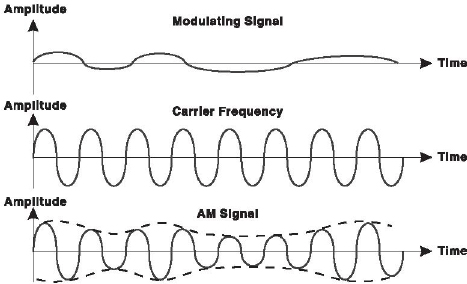
Figure 13.7 Amplitude Modulation
Frequency Modulation (FM)
In this modulation, the instantaneous frequency of carrier wave is caused to depart from the centre frequency by an amount proportional to the instantaneous value of the modulating signal. In simple words, FM is the method of impressing modulating signal onto a carrier signal wave by varying its instantaneous frequency rather than its amplitude (Figure 13.8).
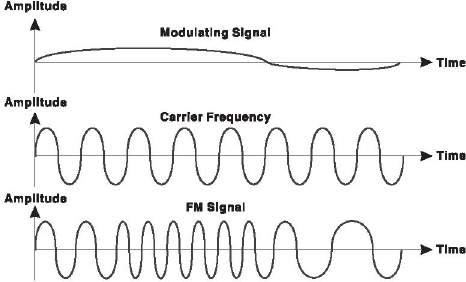
Figure 13.8 Frequency Modulation
Phase Modulation (PM)
It is the encoding of information into a carrier wave by variation of its phase in accordance with an input signal. In this modulation technique, the phase of sine wave carrier is modified according to the amplitude of the message to be transmitted. This technique is also called phase shift keying (PSK), which refers to the simple case of PM by a simple signal with only two states (Figure 13.9).

Figure 13.9 Phase Modulation
11. What do you mean by multiplexing?
Ans.: Multiplexing is a technique used for transmitting several signals simultaneously over a single communication channel. In a multiplexed system, several devices share the capacity of single communication link called common medium. The communication device (on the sender's side) that multiplexes (combines) several signals into one data communication signal to be transmitted over the common medium is called a multiplexer (MUX). At the receiving end, a demultiplexer (DEMUX) completes the communication process by separating multiplexed signals from a transmission line and distributing it to the intended receiver (Figure 13.10).

Figure 13.10 Multiplexed System
12. Differentiate between frequency division multiplexing and time division multiplexing.
Ans.: Signals are multiplexed using two basic techniques: frequency division multiplexing (FDM) and time division multiplexing (TDM). FDM is used when the bandwidth of the transmission medium between the multiplexer and demultiplexer is much greater than the requirements from any one stream being multiplexed. It is usually used for broadband analog transmissions. In this technique, signals from each sending device are modulated using carrier waves with different frequencies. These modulated signals are then combined into a single composite signal that is transported over the common medium. Each modulated signal acts as a channel. One of the most common examples of FDM is the transmission of radio stations. Figure 13.11 gives a conceptual view of FDM.
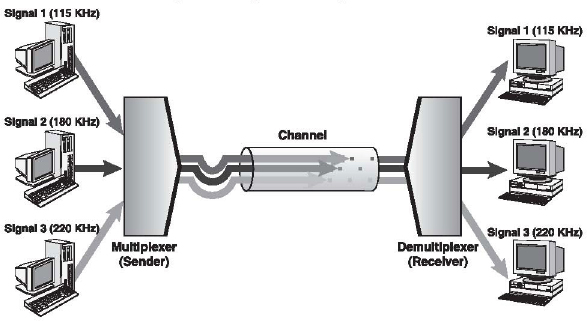
Figure 13.11 Frequency Division Multiplexing
On the other hand, TDM divides the main signal into time-slots, with each time-slot carrying a separate signal. It is used for digital communication and can be applied when the data rate capacity of the transmission medium is greater than the data rate required by the sending and receiving devices. Time division multiplexer allocates each input channel a period of time or time-slot. Figure 13.12 gives a conceptual view of TDM. Each sending device is assigned the transmission path for a predefined time-slot. Three sending signals, Signal 1, Signal 2, and Signal 3, occupy the transmission sequentially. As shown in Figure 13.12, time-slots A, B, P, Q, X, and Y follow one after the other to carry signals from the three sources, which upon reaching the demultiplexer, are sent to the intended receiver.
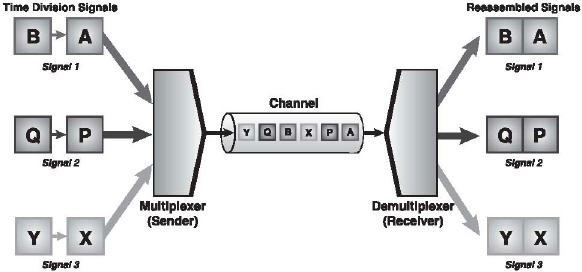
Figure 13.12 Time Division Multiplexing
13. Explain asynchronous and synchronous transmissions.
Ans.: Asynchronous and synchronous transmissions are based on serial mode of transmission. This means that only one bit is sent at a given instant; hence only one communicating channel is needed to transmit data.
Asynchronous Transmission
In asynchronous transmission, the timing of the signal is not important. The information that is received or transmitted follows a predefined pattern. As long as the patterns are followed, the receiving device can retrieve the information without any regard to the timing of the signal sent. However, a synchronizing pulse is necessary for the receiver to know when the data are coming and when they are ending. Hence, each byte of information is preceded by a start bit (denoted by 0) and ended by a stop bit (denoted by 1). Therefore, the information in 1 byte, that is, 8 bits becomes 10 bits, increasing the overheads. In addition, the transmission of each byte may be followed by a gap of varying duration, which can further help in synchronizing the information with the data stream or channel. As soon as receiver detects the stop bit, it ignores any received pulses until it detects the next start bit. The asynchronous transmission is slower than the other forms of transmission but at the same time is cheaper and an attractive choice for low-speed communication.
Synchronous Transmission
The synchronous mode of transmission works on the same media as the asynchronous transmission but the transmitter does not send start and stop bits to the receiver. The receiver's clock is synchronized with the transmitter's clock. In other words, data are transmitted as an unbroken string of 1’s and 0’s, and the receiver, on the basis of clock timings, separate the string into bytes. Timing becomes very important in synchronous transmission because without start and stop bits, there is no inbuilt mechanism to help the receiving device access the incoming information. The advantage of synchronous transmission is speed. With no extra start and stop bits, overhead is lessened, increasing the speed of transmission. Therefore, the synchronous transmission is useful for high-speed application like transfer of large data from one computer to another.
14. Define switching. Explain the three methods of switching in detail.
Ans.: Switching means routing traffic by setting up temporary connections between two or more network points. This is done by devices located at different locations on the network, called switches (or exchanges). In a switched network, some switches are directly connected to the communicating devices, while others are used for routing or forwarding information. Switching traditionally employs three methods: circuit switching, packet switching, and message switching.
Circuit Switching
When a device wants to communicate with another device, circuit switching technique creates a fixed-bandwidth channel, called a circuit, between the source and the destination. This circuit is reserved exclusively for a particular information flow, and no other flow can use it. Other circuits are isolated from each other, and thus their environment is well controlled. The path taken by data between its source and destination is determined by the circuit on which it is flowing, and does not change during the lifetime of the connection. The circuit is terminated when the connection is closed. Therefore, this method is called circuit switching. A common example of a circuit switched network is public switched telephone network (PSTN). In circuit switching, data are transmitted with no delay (except for negligible propagation delay). This method is simple and requires no special facilities. Therefore, it is well suited for low-speed data transmission.
Circuit switching was designed for voice communication. For example, in voice communication such as a telephonic conversation, once a circuit is established it remains busy for the duration of the conversation session. However, it is marred with many limitations such as in case of idle time (i.e., if no data are communicated), then the capacity of the link is wasted.
Packet Switching
Packet switching breaks data into packets, which are discrete units of potentially variable length blocks of data. Apart from data, these packets also contain a header with control information like the destination address, priority of the message, etc. These packets are passed by the source point to its local packet switching exchange (PSE). When the PSE receives a packet, it inspects the destination address contained in the packet. Each PSE contains a navigation directory specifying the outgoing links to be used for each network address. On receipt of each packet, the PSE examines the packet header information and then either removes the header or forwards the packet to another system. If the channel is not free, then the packet is placed in a queue until the channel becomes free. As each packet is received at each transitional PSE along the route, it is forwarded on the appropriate link mixed with other packets. At the destination PSE, the packet is finally passed to its destination. Note that not all packets of the same message, travelling between the same two points, will necessarily follow the same route. Therefore, after reaching their destination, each packet is put into order by a packet assembler and disassembler (PAD).
Packet switching allows packets belonging to other messages to be sent between the packets of the original message. Hence, it provides a much fairer and efficient sharing of the resources. In addition, if no data are available to the sender at some point during a communication, then no packet is transmitted over the network and no resources are wasted. Due to these characteristics, packet switching is widely used in data networks like the Internet.
Message Switching
Message switching technique employs the store and forward mechanism. In this mechanism, a special device (usually, a computer system with large storage capacity) in the network receives the message from a communicating device and stores it into its memory. Then, it finds a free route and sends the stored information to the intended receiver. In this kind of switching, a message is always delivered to one device where it is stored and then rerouted to its destination. As the delays in such switching are inherent (time delay in storing and forwarding the message) and a large capacity of data storage is required, this technique has virtually become obsolete.
15. Differentiate between circuit switching, packet switching, and message switching techniques.
Ans.: The comparison of circuit switching, packet switching, and message switching is summarized in Table 13.2.
Table 13.2 Comparison of Circuit Switching, Packet Switching, and Message Switching
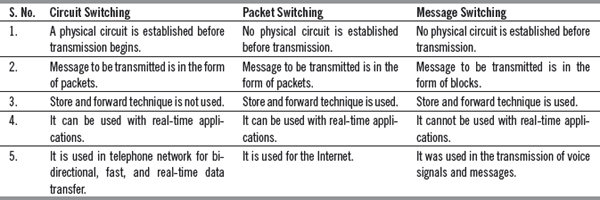
16. What is a computer network? What is the need of the computer network? What are the different criteria that a network should meet?
Ans.: A computer network is a collection of two or more computers (nodes), which are connected together to share information and resources. Nodes are connected if they are capable of exchanging information with each other. The keyword in the definition is sharing, which is the main purpose of computer networking. The ability to share information efficiently is what gives computer networking its power and appeal. To be able to provide effective communication, a network must meet certain criteria:
| Performance: Performance of a network can be determined by considering some factors such as transit time, response time, throughput, and delay. The amount of time taken by a message to travel from one device to another is known as transit time and the time elapsed between the user initiates a request and the system starts responding to this request is called the response time. The amount of work done in a unit of time is known as throughput. To achieve greater performance, we need to improve throughput and reduce the transit time, response time, and delay. However, increasing the throughput by sending more data to the network often leads to traffic congestion in the network and thus, increases the delay. Some other factors that affect the performance of a network are type of transmission medium, total number of users connected to the network, and the efficiency of connected hardware and software. | |
| Reliability: An efficient network must be reliable and robust. Reliability of a network is determined by the factors such as how frequently the failure is occurring and how much time is being spent in recovering from a link failure. | |
| Security: A network must also provide security by protecting important data from damage and unauthorized access. Also, there must be procedures and policies to handle theft and recovery of data. |
17. Write short notes on the following:
(a) Client/server network
(b) Peer-to-peer network
Ans.: (a) Client/Server Network:In client/server network, each computer is either a client or a server. To complete a particular task, there exists a centralized host computer known as server and a user's individual workstation known as client. In simple words, client requests a service from the server and the server responds by providing that service (Figure 13.13).
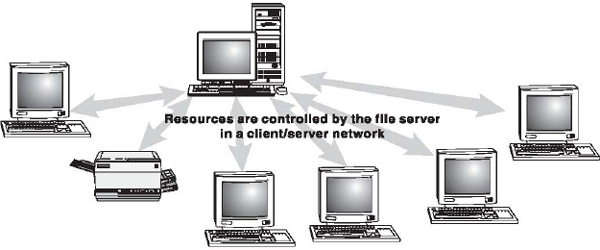
Figure 13.13 Client/Server Network
The servers provide access to resources, while the clients have access to the resources available on the servers. A typical example of client/server is sending an e-mail, where the e-mail is first transmitted to the source server. After this, the e-mail is transmitted to the destination server. Lastly, the destination server sends the e-mail to the client at the other end. Generally, the server software runs on a computer, dedicated solely for hosting that software and supporting its services. On the other hand, client software runs on common personal computers or workstations. In a client/server relationship, both the client and server carry out some of the data processing on their ends.
(b) Peer-to-Peer Network: It does not rely on dedicated servers for communication; instead, it uses direct connections between clients (peers). A pure peer-to-peer network does not have the notion of clients or servers, but only equal peer nodes that simultaneously function as both clients and servers to the other nodes on the network. That is, every node is able to initiate or complete any supported transaction (file transfer) with the other connected node (Figure 13.14).
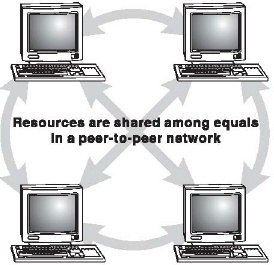
Figure 13.14 Peer-to-Peer Networks
The upper limit of the number of nodes that can function as both clients and servers on a peer-to-peer network is between 10 and 25. If there are more nodes, then a peer-to-peer machine can be used as a dedicated server with additional high-performance hardware. The peer nodes involved in the network may differ in local configuration, processing speed, network bandwidth, and storage quantity. Peer-to-peer networks have been designed primarily for small to medium local area networks. Many file-sharing services such as Morpheus and Kaaza are used extensively to find files (sound, images, and videos) on the network. However, most of these file-sharing services actually integrate both peer-to-peer and client/server networking designs. Therefore, these file-sharing applications are technically known as hybrid networks.
18. Differentiate between peer-to-peer network and client/server network.
Ans.: Both peer-to-peer and client/server networks have associated advantages and disadvantages. These advantages and disadvantages form a part of distinction between the two. These differences are listed in Table 13.3.
Table 13.3 Differences Between Peer-to-Peer Network and Client/Server Network
Basis |
Peer-to-Peer Network | Client/Server Network |
Centralized |
It has no central repository for files and applications. | Resources and data security are controlled through the server. |
Maintenance |
It has low maintenance cost file. | A large network requires extra staff to ensure efficient operation. |
Installation |
It can be easily installed. | It requires experts for proper installation of the network. |
Expensive |
There is no need for a dedicated server, thus it is not much expensive. | It is expensive, as it requires a dedicated server. |
Security |
Lack of proper security policies is its biggest drawback. | It provides high level of security. |
Dependence |
All nodes are independent of each other. Failure occurring in one node does not affect the functioning of other nodes in the network. | When server goes down, it affects the functioning of the entire network. |
19. Differentiate between 2-tier and 3-tier network architectures?
Ans.: The 2-tier architecture is used to define client/server systems where the client requests the resources and server responds directly to the request, using its own resources. This means that the server does not call on another application in order to provide part of the service. This architecture has two essential components: a client PC and a data server. The 2-tier architecture has various features:
| It has simple structure. | |
| It is easy to set up and maintain. | |
| In this architecture, business logic and database are physically close that results in higher performance. |
On the other hand, in 3-tier architecture, there is an intermediary level, that is, the architecture is generally split up between three essential components: a client PC, an application server (also called middleware), and a data server. A client requests the resources with its browser, an application server provides the requested resources, but by calling another server, and the data server provides required data to the application server. The 3-tier architecture has various features:
| It provides a greater degree of flexibility. | |
| Complex application rules are easy to implement in the application server. | |
| This architecture provides efficient performance for medium to high volume environments as tasks are shared between servers. | |
| It offers high security as it can be defined for each service and at each level. |
20. Explain different computer networks in detail.
Ans.: The computer networks have been classified into three different types: local area network (LAN), metropolitan area network (MAN), and wide area network (WAN).
LAN
It is a computer network that covers only a small geographical area (usually within a square mile or less) such as an office, home, or building. In a LAN, connected computers have a network operating system installed onto them. One computer is designated as the file server, which stores all the software that controls the network. It also stores the software that can be shared by the computers attached to the network. Other computers connected to the file server are called workstations. The workstations can be less powerful than the file server, and they may have additional software on their hard drives. On most LANs, cables are used to connect the computers. Generally, it offers a bandwidth of 10–100 Mbps.
MAN
It is a network of computers spread over a ‘metropolitan’ area such as a city and its suburbs. As the name suggests, this sort of network is usually reserved for metropolitan areas where the city bridges its LANs with a series of backbones, making one large network for the entire city. It may be a single network such as a cable television network or it may be a means of connecting a number of LANs. Note that MAN may be operated by one organization (a corporate with several offices in one city), or be shared and used by several organizations in the same city.
WAN
It is a system of interconnecting many computers over a large geographical area such as cities, states, countries, or even the whole world. These kinds of networks use telephone lines, satellite links, and other long-range communications technologies to connect. Such networks are designed to serve an area of hundreds or thousands of miles such as public and private packet switching networks and national telephone networks. For example, a company with offices in New Delhi, Chennai, and Mumbai may connect the LANs for each of those locations to each other through a WAN. Although a WAN may be owned or rented by private business, it is usually a public network designed to connect small and intermediate-sized networks together. The largest WAN in existence is the Internet. It offers many advantages to business organizations. Some of them are as follows:
| It offers flexibility of location because not all the people using the same data have to work at the same site. | |
| Communication between branch offices can be improved using e-mail and file sharing. | |
| It facilitates a centralized company-wide data back-up system. | |
| Companies located in a number of small, interrelated offices can store files centrally and access each other's information. |
21. What are the various advantages of a computer network?
Ans.: Today, a computer network is being used in every facet of life as it provides the following advantages:
| Sharing information: This is one of the most important advantages of a computer network. In the absence of a network, transferring information from one computer to another requires use of a compact disk, floppy disk, printer, etc. However, if the communicating systems are geographically apart, sharing information becomes even harder. The computer network solves this problem as computers connected to a network can share information as if they are in the same building even when they are located geographically apart. For example, when we connect to the Internet and open a website on our computer, we can access information that is not stored in our own computers. In such a networked system, all information is stored on a central, powerful computer known as a server. All other computers in the network can easily access information from the server as if it was located on their own computer. | |
| Sharing hardware resources: A network facilitates sharing of hardware resources in an effective and user-friendly manner. When computers are connected to a network, they can share peripherals such as printer, hard disk drives, etc. with any other computer. For example, in an office having 5–10 computers and 1 printer, in the absence of network, only the computer that is connected to the printer can be used to print data. If others have to access the printer, then they would first need to transfer their data over to the computer connected to the printer. Contrastive to this, in a networked environment, the printer can be shared on the network and every computer on the network can easily access the printer without having the need to transfer data. | |
| Sharing software resources: Software resources are the programs or applications that are used by computers to perform any useful function or to carry out daily basis task. In an environment where networking is not available, users will have to install and configure any applications that they need individually. However, if the computers are connected via a network, the required software or application can be installed and configured centrally on a server and shared by all. This saves the valuable time and disk space. | |
| Preserve information: In addition to sharing information, a networked environment helps to preserve information as well. It is difficult to maintain regular back-ups of data on a number of stand-alone computers and without back-up, important data can be lost in case of some accident or failure of computer. However, in a networked environment, a copy of the important data can be kept on the server as well as on other connected computers on the network. In this case, failure of one computer will not result in the loss of information as the data can still be accessed from other computers whenever required. | |
| Communication: Computer network has revolutionized the way people communicate. Rather than exchanging memos and directives on paper, which involves a lot of printing costs and delays, network users can instantly send messages to others and even check whether their messages have been received. |
22. What are the various applications of a computer network?
Ans.: Nowadays, a computer network has become an essential part of industry, entertainment world, business, as well as our daily lives. Some of the applications of the computer network in different fields are as follows:
| Business applications: There is a need of effective resource sharing in companies for the exchange of ideas. This can be achieved by connecting a number of computers with each other. It allows transferring of business information effectively without using paper. For example, an employee of one department can access the required information about another department using the network. | |
| Marketing and sales: Marketing firms utilize networks for conducting surveys to gather and analyze data from the customers. This helps them to understand the requirements of a customer and use this information in the development of the product. Sales professionals can use various applications such as online shopping, teleshopping, and online reservation for airlines, hotel rooms, etc. in order to increase the revenue of their organization. | |
| Financial services: A computer network plays a major role in providing financial services to people across the globe. For example, the financial application such as electronic fund transfer helps the user to transfer money without going into a bank. Some other financial applications that are entirely dependent on the use of networks include ATM, foreign exchange and investment services, credit history searches, and many more. | |
| Directory and information services: Directory services permit a large number of files to be stored in a central location thereby speeding up the worldwide search operations. Information services of Internet such as bulletin boards and data banks provide a vast amount of information to the users within seconds. | |
| Manufacturing: Computer networks are widely being used in manufacturing. For example, applications such as computer-aided design (CAD) and computer-assisted manufacturing (CAM) use network services to help design and manufacture the products. | |
| E-mail services: This is one of the most widely used applications of network. With the help of computer networks, one can send mails across the world within a few seconds and without using paper. | |
| Mobile applications: With the help of mobile applications such as cellular phones and wireless phones, people wishing to communicate are not bound by the limitation of being connected by fixed physical connections. Cellular networks allow people to communicate with each other even while travelling across large distances. | |
| Conferencing: With the help of networking, conferencing (teleconferencing or videoconferencing) can be conducted that allows remotely located participants to communicate with each other as if they are present in the same room. |
23. What are the disadvantages of networking?
Ans.: Whenever more than one computer is used at the same location, networking them together facilitates exchange of data and information between connected computers in a fast and efficient manner. It also helps sharing expensive resources like printers, back-up tape drives, scanners, Internet connections, etc. Along with various advantages, it also has some disadvantages:
| In case of sudden breakdown in the server, users may be unable to run the application program and it may also cause users to loose the important data. | |
| Any fault in networking may terminate the connection between various computers. | |
| Increase traffic on network lines affects the performance of the network. | |
| Laying down large network may require huge cabling that can be expensive to install and replace. | |
| Networks are vulnerable to many kinds of threats from hackers, novices, and espionage that can cause various types of damages such as possibility of stealing of vital information and intentionally implanting destructive programs onto other computer systems. |
24. Define network topology. Describe commonly used network topologies with their relative advantages and disadvantages.
Ans.: The term ‘topology’ refers to the way a network is laid out, either physically or logically. It can be considered as the network's shape. It is the geometric representation of the relationship of all the links. There are five basic topologies: bus, ring, star, tree, and mesh topologies.
Bus Topology
It uses a common bus or backbone (a single cable) to connect all devices with terminators at both ends. The backbone acts as a shared communication medium and each node (file server, workstations, and peripherals) is attached to it with an interface connector. Whenever a message is to be transmitted on the network, it is passed back and forth along the cable, past the stations (computers), and between the two terminators, from one end of the network to the other. As the message passes each station, the station checks the message's destination address. If the address in the message matches the station's address, the station receives the message. If the addresses do not match, the bus carries the message to the next station, etc. Figure 13.15 illustrates how devices such as file servers, workstations, and printers are connected to the linear cable or the backbone.

Figure 13.15 Bus Topology
The advantages of bus topology are as follows:
| Connecting a computer or peripheral to a linear bus is easy. | |
| This topology requires least amount of cabling to connect the computers and, therefore, less expensive than other cabling arrangement. | |
| It is easy to extend a bus since two cables can be joined into one longer cable with a connector. |
The disadvantages of bus topology are as follows:
| Entire network shuts down if there is a failure in the backbone. | |
| Heavy traffic can slow down a bus because computers on such networks do not coordinate with each other to reserve time to transmit. |
Ring Topology
In ring topology, computers are placed on a circle of cable without any terminated ends since there are no unconnected ends. Every node has exactly two neighbours for communication purposes. All messages travel through a ring in the same direction (clockwise or counterclockwise) until it reaches its destination. Each node in the ring incorporates a repeater. When a node receives a signal intended for another device, its repeater regenerates the bits and passes them along the wire (Figure 13.16).
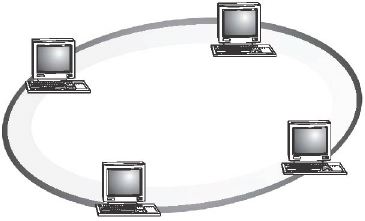
Figure 13.16 Ring Topology
The advantages of ring topology are as follows:
| It is easy to install and reconfigure. | |
| Every computer is given equal access to the ring. Hence, no single computer can monopolize the network. |
The disadvantages of ring topology are as follows:
| Failure in any cable or node breaks the loop and can take down the entire network. | |
| Maximum ring length and number of nodes are limited. |
Star Topology
In star topology, devices are not directly linked to each other but they are connected via a centralized network component known as hub or concentrator (Figure 13.17). The hub acts as a central controller and if a node wants to send data to another node, it boosts up the message and sends the message to the intended node. This topology commonly uses twisted pair cable; however, coaxial cable or fibre-optic cable can also be used. Many organizations use the star topology in a time-sharing system, in which several users are able to share a central processor.
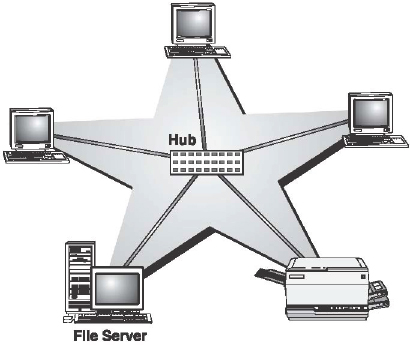
Figure 13.17 Star Topology
The advantages of star topology are as follows:
| It is easy to install and wire. | |
| The network is not disrupted even if a node fails or is removed from the network. | |
| Fault detection and removal of faulty parts is easier in star topology. |
The disadvantages of star topology are as follows:
| It requires a longer length of cable. | |
| If the hub fails, nodes attached to it are disabled. | |
| The cost of the hub makes the network expensive as compared to bus and ring topologies. |
Tree Topology
It combines characteristics of linear bus and star topologies. It consists of groups of star-configured workstations connected to a bus backbone cable. Not every node plugs directly to the central hub. The majority of nodes connect to a secondary hub that, in turn, is connected to the central hub. Each secondary hub in this topology functions as the originating point of a branch to which other nodes connect (Figure 13.18).
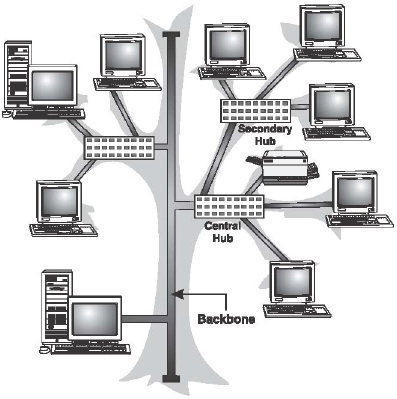
Figure 13.18 Tree Topology
The advantages of tree topology are as follows:
| The distance to which a signal can travel increases as the signal passes through a chain of hubs. | |
| It allows isolating and prioritizing communications from different nodes. | |
| It allows for the easy expansion of an existing network, which enables organizations to configure a network to meet their needs. |
The disadvantages of tree topology are as follows:
| If the backbone line breaks, the entire segment goes down. | |
| It is more difficult to configure and wire than other topologies. |
Mesh Topology
In a mesh topology, every node has a dedicated point-to-point link to every other node (Figure 13.19). Messages sent on a mesh network can take any of several possible paths from source to destination. A fully connected mesh network has n(n - 1)/2 physical links to link n devices. For example, if an organization has 5 nodes and wants to implement a mesh topology, then 5(5 - 1)/2, that is, 10 links are required. In addition, to accommodate those links, every device on the network must have n - 1 communication (input/output) ports.
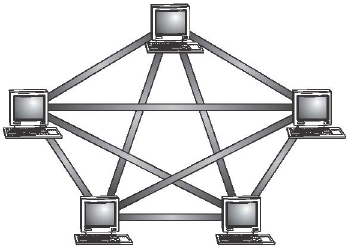
Figure 13.19 Mesh Topology
The advantages of mesh topology are as follows:
| The use of large number of links eliminates network congestion. | |
| If one link becomes unusable, it does not disable the entire system. |
The disadvantages of mesh topology are as follows:
| The amount of cabling required is very large. | |
| As every node is connected to the other, installation and reconfiguration is very difficult. | |
| The amount of hardware required in this type of topology makes it expensive to implement. |
25. Describe OSI model.
Ans.: Open systems interconnection (OSI) is a standard reference model for communication between two end-users in a network. In 1983, International Organization for Standardization (ISO) published a document called The Basic Reference Model for Open Systems Interconnection, which visualizes network protocols as a seven-layered model. The model lays a framework for the design of network systems that allow for communication across all types of computer systems. It consists of seven separate but related layers (Figure 13.20):
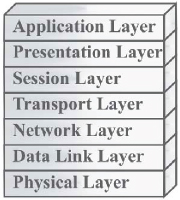
Figure 13.20 Message Transfer in Layered Architecture
- Physical layer: It defines the physical and electrical characteristics of the network. This layer acts as a conduit between computer's networking hardware and its networking software. It handles the transfer of bits (0’s and 1’s) from one computer to another. This is where the bits are actually converted into electrical signals that travel across the physical circuit. Physical layer communication media include various types of copper or fibre-optic cable, as well as many different wireless media.
- Data link layer: It provides service interface to the network layer and is responsible for error-free transmission and preventing the slow receivers from being overflowed by the fast senders. To achieve this, it divides the packets received from the network layer into manageable form known as frames. These data frames are then transmitted sequentially to the receiver. On the receiver end, it detects and corrects any errors in the transmitted data, which it gets from the physical layer.
- Network layer: This layer is responsible for transporting traffic between devices that are not locally attached. For example, a router (a network layer device) provides the routing services in a network. When a packet is received on a router interface, the destination IP address is checked. If the packet is not destined for the router, then the router will look up the destination network address in the routing table. Once an exit interface is chosen, the packet will be sent to the interface to be framed and sent out on the local network. If the entry for the destination network is not found in the routing table, the router drops the packet.
- Transport layer: The basic function of the transport layer is to handle error recognition and recovery of the data packets. This layer establishes, maintains, and terminates communications between the sender and the receiver. At the receiving end, it rebuilds packets into the original message, and to ensure that the packets have arrived correctly, the receiving transport layer sends acknowledgments.
- Session layer: It comes into play primarily at the beginning and end of a transmission. At the beginning of the transmission, it lets the receiver know its intent to start transmission. At the end of the transmission, it determines if the transmission was successful. This layer also manages errors that occur in the upper layers such as a shortage of memory or disk space necessary to complete an operation, or printer errors.
- Presentation layer: It ensures that information sent from the application layer of one system would be readable by the application layer of another system. This is the place where application data are packed or unpacked and are made ready to use by the running application. This layer also manages security issues by providing services such as data encryption and compresses data so that fewer bits can be transferred on the network.
- Application layer: It is the entrance point that programs use to access the OSI model and to utilize network resources. This layer represents the services that directly support applications. This OSI layer is closest to the end-user. It includes network software that directly serves the end-users of the network by providing them user interface and application features like electronic mail, USENET, etc.
26. Explain in brief on TCP/IP reference model.
Ans.: TCP/IP (stands for transmission control protocol/Internet protocol) model was developed by the U.S. Department of Defense (DoD) to connect multiple networks and preserve data integrity. It came after the OSI model and the numbers of layers in TCP/IP differs from that of the OSI model. It comprises of four layers: network access (also called host-to-network layer), Internet, transport, and application layers.
The network access layer of TCP/IP model corresponds to the combination of physical and data link layers of the OSI model. The Internet layer corresponds to the network layer of the OSI model, and the application layer performs tasks of session, presentation, and application layers of the OSI model with the transport layer of the TCP/IP performing a part of responsibilities of the session layer of the OSI model (Figure 13.21).

Figure 13.21 TCP/IP Model
TCP/IP suite contains a group of protocols forming a hierarchy such that the lower layer protocols support upper layer protocols.
- Network Access Layer: This layer does not rely on specific protocol, hence supports all standard protocols. It connects two nodes to the network with the help of some protocol and moves data across two nodes that are connected via same link. The nodes after connection can transfer IP packets to each other.
- Internet Layer: The main function of this layer is to enable the hosts to transmit packets to different networks by taking any of the routes available for reaching at the destination. This layer strengthens the whole architecture and defines the format of packet. The rules to be followed while delivering the packets are transparent to the users. It supports many protocols such as Internet protocol (IP), address resolution protocol (ARP), reverse address resolution protocol (RARP), Internet control message protocol (ICMP), and Internet group message protocol (IGMP). IP is an unreliable and connectionless protocol that transmits data in the form of packets called datagrams. Each datagram is transmitted independently and can travel through a different route. Moreover, the datagrams may reach at the destination not necessarily in the order in which they were sent or may be duplicated. IP neither keeps track of the routes followed by the datagrams nor does it perform any error checking. It tries its best to deliver the datagrams at their intended destinations, however does not ensure the delivery. ARP is used to identify the physical address of a node whose logical address is known. RARP performs just the reverse of ARP, that is, it enables a host whose physical address is known to identify its logical address. This protocol is used when a new node is connected to the network or when an already connected node is formatted. ICMP is used to send error messages to the sender in case the datagram does not reach at its destination. IGMP is used to deliver the same message to a number of recipients at the same time.
- Transport Layer: The main function of this layer is to deliver a message from a process on the source machine to a process on the destination machine. This layer is designed to allow end-to-end conversation between peer entities. It uses three protocols: transmission control protocol (TCP), user datagram protocol (UDP), and stream control message protocol (SCMP) to accomplish its responsibilities. TCP is a connection-oriented protocol that means a connection must be established between the source and the destination before any transmission begins. It is also a reliable protocol as it ensures error-free delivery of data to the destination. UDP is an unreliable and a connectionless protocol that performs very limited error checking. SCTP is the combination of UDP and TCP and it supports advanced features such as voice over the Internet.
- Application Layer: This layer contains all the high-level protocols such as file transfer protocol (FTP) and virtual terminal (TELNET). Some more protocols that were added later include domain name service (DNS), hyper text transfer protocol (HTTP), and many more. With the help of various protocols, this layer integrates many activities and responsibilities for effective communication.
27. Compare OSI model with TCP/IP model.
Ans.: OSI and TCP/IP are layered models that allow the computer systems to communicate with each other. The OSI reference model was developed by ISO in order to standardize the protocols being used in various layers and the TCP/IP model was developed by DoD to connect multiple networks. Both models have some of the following similarities:
| Both OSI and TCP/IP models use the set of independent protocols for enabling communication between users. | |
| In both the models, upper layers focus on application such as web browser and lower layers focus on end-to-end delivery of data. |
The differences between OSI and TCP/IP models are listed in Table 13.4.
Table 13.4 Differences Between OSI and TCP/IP Models
S. No. |
OSI Model | TCP/IP Model |
1. |
It is a seven layer model. | It is a four layer model. |
2. |
It was unable to connect to radio and satellite networks. | It had the ability to connect to radio and satellite networks. |
3. |
It supports only connection-oriented communication in transport layer while both connection-oriented and connectionless communication in network layer. | It supports both connection-oriented and connectionless communication in transport layer while only connectionless communication in network layer. |
4. |
It clearly distinguishes between services, interfaces, and protocols. | It does not clearly distinguish between services, interfaces, and protocols. |
5. |
It was defined before the invention of the Internet. | It was defined after the invention of the Internet. |
6. |
It was developed before the corresponding protocols came into existence. | It was developed after the protocols came into existence. |
28. Write short notes on the following:
(a) Network interface card (NIC)
(b) Repeater
(c) Hub
(d) Bridge
(e) Switch
(f) Router
(g) Gateway
Ans.: (a) Network interface card (NIC): It is a hardware device that connects clients, servers, and peripherals to the network through a port. Most network interfaces come as small circuit board that can be inserted onto one of the computer motherboard's slots. Alternatively, modern computers sometimes include the network interface as part of their main circuit boards (motherboards). Each network interface is associated with a unique address called its media access control (MAC) address. The MAC address helps in sending information to its intended destination. NIC is a major factor in determining the speed and performance of a network. It is a good idea to use the fastest network card available for the type of workstation one is using.
(b) Repeater: It is the most basic device on a network. Signals that carry information within a network can travel a fixed distance before attenuation endangers the integrity of the data. A repeater installed on the link receives signal, regenerates it, and sends the refreshed copy back to the link. Doing this means that the new signal is clean, free from any background noise introduced while travelling down the wire.
It is most commonly used to extend a network cable. All network cable standards have maximum cable length specification. If the distance between two network devices is longer than this specification, a repeater is needed to regenerate the signal. Without the repeater, the signal will be too weak for the computers on each end to reliably understand. A good example of the use of repeaters would be in a LAN using a star topology with UTP cabling. The length limit for UTP cable is 100 m. The repeater amplifies all the signals that pass through it allowing for the total length of cable on the network to exceed the 100-m limit. Nonetheless, it has no inbuilt intelligence and does not look at the contents of the packet as it regenerates the signal. Thus, there is no processing overhead in sending a packet through a repeater. This also means that it will repeat any errors in the original signal.
(c) Hub: It is a small box that connects individual devices on a network so that they can communicate with one another. It operates by gathering the signals from individual network devices, optionally amplifying the signals, and then sending them onto all other connected devices. Amplification of the signal ensures that devices on the network receive reliable information. It can be thought of as the centre of a bicycle wheel, where the spokes (individual computers) meet. At very basic level, it can be thought of as a multi-port repeater. Typically, It has anywhere from 4 to over 400 ports. When a signal is received on one port of the hub, it is regenerated out to all the other ports. It is most commonly used to connect multiple machines on the same LAN. Administrators connect a computer to each port on the hub, leaving one port free to connect to another hub or to a higher-level device like a bridge or router.
(d) Bridge: It is a device that allows the division of a large network into two or more smaller and efficient networks. It monitors the information traffic on both sides of the network so that it can pass packets of information to the correct location. Most bridges can listen to the network and automatically figure out the address of each computer on both sides of the bridge. It examines each packet as it enters though one of the ports. It first looks at the MAC address of the sender and creates a mapping between the port and the sender's MAC address. It then looks at the address of the recipient, comparing the MAC address to the list of all learned MAC addresses. If the address is in the list, it looks up the port number and forwards the packet to the port where it thinks the recipient is connected. If the recipient's MAC address is not in the list, it then does a flood, that is, it sends the signal to all the ports except the one from where it was received. As a result, it reduces the amount of traffic on a LAN by dividing it into two segments. It inspects incoming traffic and decides whether to forward or discard it.
It can be used to connect networks with different types of cabling or physical topologies. It must, however, be used between networks with the same protocol. Since it examines the packet to record the sender and look ups the recipient, there is overhead in sending a packet through a bridge. On a modern bridge, this overhead is miniscule and does not affect network performance.
(e) Switch: It is a multi-port bridge. It connects individual devices on a network so that they can communicate with one another. The behaviour of a switch is same as that of a bridge. It is capable of inspecting the data packets as they are received, determining the source and destination device of that packet, and forwarding that packet appropriately. The difference is that most switches implement these functions in hardware using a dedicated processor. This makes them much faster than traditional software-based bridges.
(f) Router: It is an essential network device for interconnecting two or more networks. Its sole aim is to trace the best route for information to travel. As network traffic changes during the day, it can redirect information to take less congested routes. It creates and/or maintains a table, called a routing table that stores the best routes to certain network destinations. While bridges know the addresses of all computers on each side of the network, routers know the addresses of computers, bridges, and other routers on the network. It can even listen to the entire network to determine which sections are the busiest and can then redirect data around those sections until they clear up.
It is generally expensive and difficult to configure and maintain. It is the critical component of a network and if it fails, the network services will be significantly impaired. Most routers operate by examining incoming or outgoing signals for information at the network layer. In addition, it can permit or deny network communications with a particular network.
(g) Gateway: It is an Internet-working device, which joins networks operating on different protocols together. It is also known as protocol converter. It accepts the packet formatted for one protocol and converts the formatted packet into another protocol. It can be implemented completely in software, hardware, or as a combination of both. For example, it can receive e-mail message in one format and convert it into another format. One can connect systems with different protocols, languages, and architecture using a gateway.
29. Differentiate between switch and hub.
Ans.: The differences between switch and hub are listed in Table 13.5.
Table 13.5 Differences Between Switch and Hub
S. No. |
Switch | Hub |
1. |
It operates at the data link layer. | It operates at the physical layer. |
2. |
It is a complex device and more expensive than a hub. | It is a simple device and cheaper than switch. |
3. |
It is a full-duplex device and more secured. | It is a half-duplex device and less secured. |
4. |
Each port of switch has its own collision domain, that is, each port has buffer space for storing frame so when two frames arrive at the same time, frame will not be lost. | The entire hub forms a single collision domain, that is, when two frames arrive at the same time they will always collide and hence frame will be lost. |
5. |
It is an intelligent device as it maintains a table to transmit the frame to the intended recipient. | It is a non-intelligent device as each time frame is broadcast to all the connected nodes. |
6. |
It utilizes the bandwidth effectively. | Wastage of bandwidth is more in the case of hub. |
30. Differentiate between router and switch.
Ans.: Some differences between the router and switch are listed in Table 13.6.
Table 13.6 Differences Between Router and Switch
S. No. |
Router | Switch |
1. |
It connects nodes on different networks. | It connects nodes within the same network. |
2. |
It operates in the network layer. | It operates in the data link layer. |
3. |
It uses IP address for the transmission of packets. | It uses MAC for the transmission of frames. |
4. |
It is more intelligent and complex than switch. | It is less intelligent and simpler than router. |
5. |
Various algorithms are used to forward packets along their best path. | No such algorithms are used by switch. |
6. |
It needs to be configured before using. | Most switches are ready to use and need not be configured. |
Multiple-choice Questions
1. The transmission mode that allows both communicating devices to transmit and receive data simultaneously is __________.
(a) Simplex
(b) Full-duplex
(c) Half-duplex
(d) None of these
2. Which of the following media does not come under the guided media?
(a) Optical fibres
(b) Coaxial cable
(c) Microwave
(d) Twisted pair
3. Which of the following cables support the highest bandwidth and faster transmission rate?
(a) Fibre-optic cable
(b) Coaxial cable
(c) UTP cable
(d) Twisted pair cable
4. A PSTN uses __________ switching technique.
(a) Packet
(b) Message
(c) Circuit
(d) None of these
5. LAN stands for __________.
(a) Long area network
(b) Local area network
(c) Local audible network
(d) Limited area network
6. A computer network that provides long distance transmission of data, images, and sound over a large distance is __________.
(a) MAN
(b) WAN
(c) LAN
(d) VAN
7. The network topology in which devices are not linked to each other and where hub acts as a central controller is __________.
(a) Mesh topology
(b) Star topology
(c) Ring topology
(d) Tree topology
8. In ring topology, each __________.
(a) Node is connected to exactly two others for communication purposes.
(b) Device is connected to a control unit; communication between one device and another must go through the central unit.
(c) Node in the ring incorporates a repeater.
(d) Both (a) and (c).
9. The network device that connects two or more networks together and whose sole aim is to trace the best route for the information to travel is __________.
(a) Hub
(b) Gateway
(c) Switch
(d) Router
10. Identify the odd term out.
(a) Router
(b) Switch
(c) PC
(d) NIC
Answers
1. (b)
2. (c)
3. (a)
4. (c)
5. (b)
6. (b)
7. (b)
8. (d)
9. (d)
10. (c)
